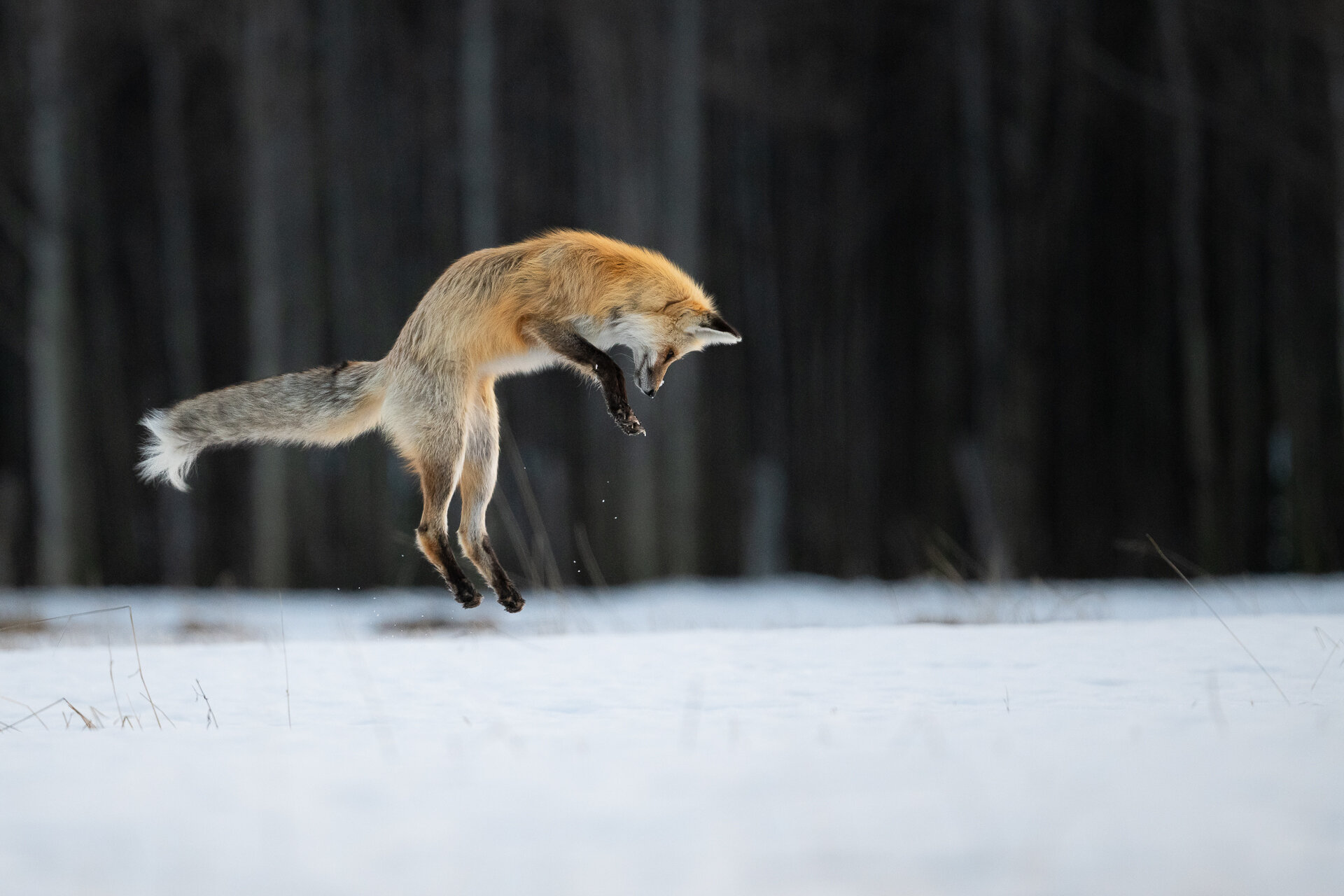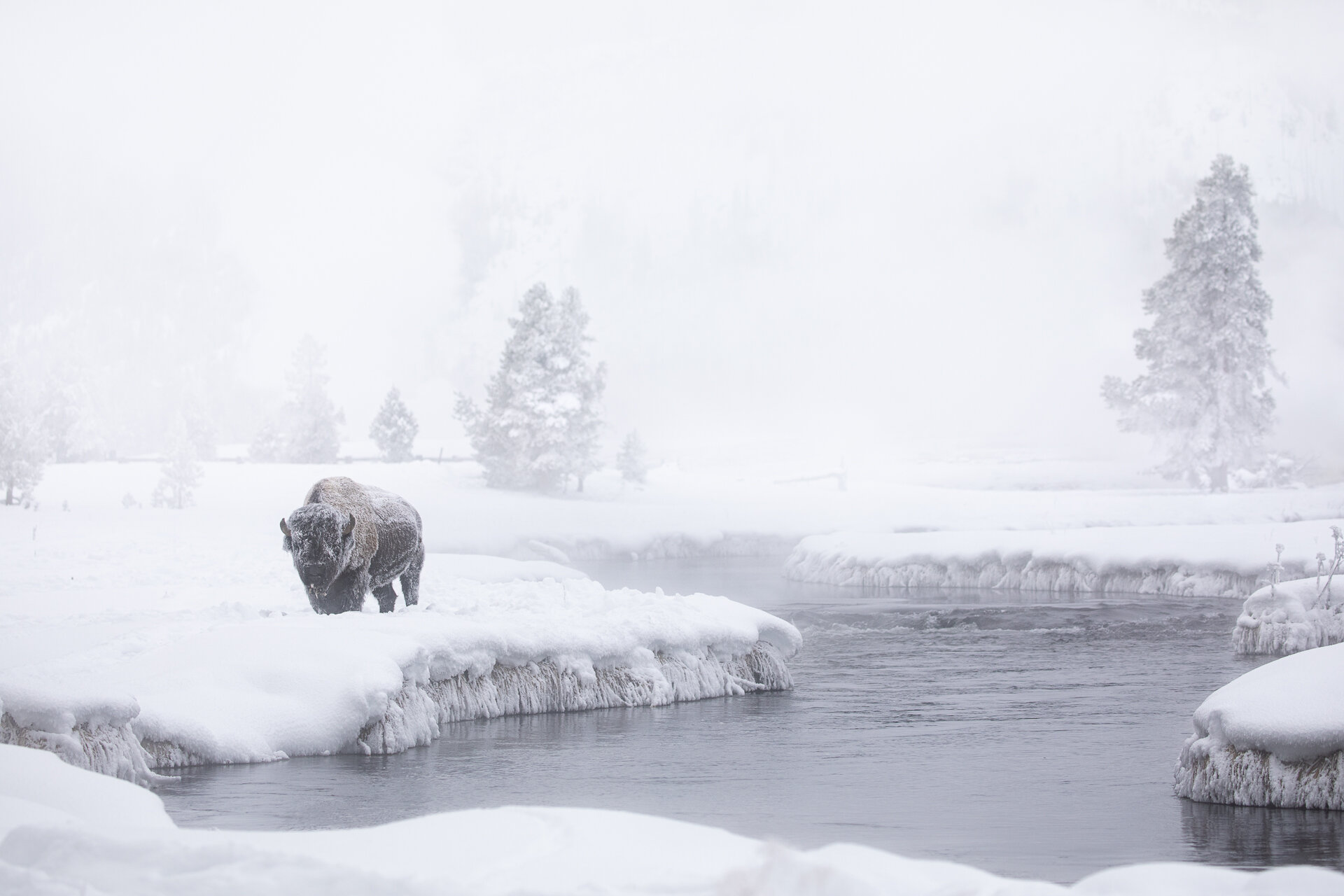It’s spring, finally. The snow is rapidly loosening it’s grip on the land. Pocket gophers and voles are still hunkered down beneath the small white patches that remain, and this experienced red fox is taking advantage of the cover that provides for hunting. Stay tuned to see whether she was successful...
Lone Bison
A lone bison grazes along the Firehole in Yellowstone National Park.
Presence of the Canada Lynx
Besides the shocking disproportionate size of their feet, the calm and mesmerizing presence of the Canada Lynx is what stands out to me. Unlike most other cat species, the lynx I’ve encountered appear to be relatively comfortable with me, often sitting down and watching me before stealthily vanishing into the forest cover.
Bull Bison in Grand Teton
This may be my favorite thing to see in the winter...a big bull bison covered in frost. The winter coat of a bison is so well insulating that there isn’t enough heat escaping their body to melt the frost. I’ve been able to photograph this bull several times over the last couple years. His exceptionally red coat, and the red patch on his face, make him easily recognizable.
Bighorn Rams in Jackson Hole
Bighorn sheep are fairly elusive for most of the year, as they spend most of their time in the mountains. In the winter they are forced down to lower elevations to feed and become much more visible.
Red Fox in Grand Teton
There are few things I find more visually striking than a red fox against the white snow. I found this fox as it was hunting for rodents under the snow. The fox will listen carefully for movement under the snow, turning its head back and forth to pin point the sound before leaping into the air and diving head first into the snow.
Bison - Winter Warriors
As winter settles and temperatures reach -40 degrees, perhaps no animal is as well prepared to survive in this unforgiving climate.
The distinct shoulder hump on their back, which is actually a protruding muscle, allows them to function as a 1 ton, living snow plow. Unlike other ungulates, such as moose and elk, which scrape with their front feet to access food under the snow, bison use this muscle to rock their massive heads back and forth exposing grass and sedge buried under several feet of snow. Some bison will opt out on this “snow-plow” technique, preferring to graze alongside thermal features where the warm steam from geysers or hot springs melts the snow on the surrounding grass.
When violent winter storms hit, prompting other wildlife to seek shelter from the chilling wind and blinding snow, bison just plop down where they are and wait it out. Their winter coats are so thick and well insulated that the falling snow doesn’t even melt on their back. In a heavy snow, you can watch the largest land animal North America vanish before your eyes in a matter of moments.
The Dive
A humpback whale dives to begin bubble-net feeding in the Great Bear Rainforest.
Summer Elk Behavior
While the cow elk are busy raising their young, the bulls stick together in small bachelor herds. Thanks to the nutritious grazing opportunities summer provides, their antlers, covered in velvet, begin regrowing up to an inch per day.
A cow elk walks the bank of the Madison River with her newborn calf.
Two newborn elk calves prepare to cross the Madison river to join their mothers.
Winter Wildlife Feature V - Coyote
Coyotes are perhaps one the most underestimated members of the Greater Yellowstone Ecosystem. This highly intelligent and adaptable specifies deserves a spotlight. Their success making a living on a harsh landscape is due to a remarkable resourcefulness. I recently watched a coyote over several hours fishing for trout in a river, ambushing waterfowl on the river bank, pouncing in the snow for small rodents, and stealing bites of bison from a recent wolf kill that the pack had left temporarily unattended. The variety of creative ways coyotes utilize to find food is impressive.
For the majority of the year most coyotes run solo, or in pairs as they raise pups, but in the winter it’s not uncommon to see them in packs with up to 5 or more members. This confidence in numbers allows them to take on larger prey, and maybe even to feel more secure as they traverse a winter landscape dominated by their larger not-so-tolerant relative, the wolf.
Winter Wildlife Feature IV - Ermine
At first glance these slender weasels appear at a serious disadvantage when it comes to keeping warm in the winter. They have practically no body fat, and relatively little fur in their winter coats, but an ermine has several unique features and strategies to make up for it.
For one, their coat turns from brown to white each winter, allowing them to be nearly invisible as they move through a snow white landscape. Their tail has a black tip on the end, which functions as a decoy luring any potential predators to strike there, rather than a more vulnerable part of the body.
To make up for a lack of body fat and extra fur, they generate body heat with their cranked up metabolism. Essentially, they turn their body into a heater, eating up to 6 times a day. When ermines do take time to rest, it needs to be in an insulated location. The den of a chipmunk or vole they just killed fits the bill perfectly. Another tactic ermines are known to employ is actually lining the inside of a log or den with the fur of their victims to keep warm.
Winter in Yellowstone - Intro
Winter in the Greater Yellowstone marries serene beauty and harsh realities in a way only an arctic like cold can. On some days you may be excused for mistakenly thinking you were located in the polar zone. Last January on my photography worksop we spent a day in the field with low temps reaching -40° F (40° C). Severe cold, blustering winds, and limited food resources present supreme challenges for wildlife to overcome. Nothing has kindled a deeper sense of respect for the fortitude and adaptability the inhabitants of this ecosystem posses than my time photographing them in the winter. The next series of posts over the coming days will highlight individual animals and their unique strategies for surviving, and even thriving in the gauntlet of winter.
Weasels!
An ermine takes a brief moment to stand up and take in it’s surroundings before resuming the frantic hunt for prey at what appears to be lightspeed. It’s near impossible to keep track of these weasels for more than a few moments. They trade a brown summer coat for a white one each winter. Their cranked up metabolism allows them to keep warm by compensating for their lack of body fat.
Shortly after I photographed the ermine, I located a family of river otters, which are also a member of the weasel family. We tend to have negative connotations with the word “weasel”, but some of my favorite animals to spend with and observe are weasels.
Yellowstone Grizzlies
“In part because bears can be so dangerous, they force you to pay attention. The awe of being in their presence strips away the chaos of thoughts and distractions that normally dominate your consciousness. They focus your attention on the moment. They flood your blood with adrenaline and endorphins…. They introduce you to terror, awe, amazement and ecstasy. They connect you to the deepest pulses of life. This is their gift. The power to take your life, or to renew it; to re-create who you are, if only for a moment, and perhaps for a lifetime.” - Dr. Stephen F. Stringham
Rutting Bison
With population estimates at one point as high as 50 million, it is hard to believe that in 1902 there were only a couple dozen bison left in the lower 48. If those few survivors were not protected from poaching in Yellowstone, this iconic species would be missing from the Greater Yellowstone landscape.
I caught this large bull, weighing close to 2000 lbs, as he wallowed in the dirt and marked it with his scent. As he shook the dirt off his back the area surrounding him faded into a cloud of dust.
Silent Huntress - Great Grey Owl
Observing and photographing this skilled huntress work the shadows of the forest is always special. This Great Grey Owl may strategically and silently watch her prey for an hour before moving in for the kill.
Dusky Grouse
The male dusky grouse is unquestionably one of the most beautiful birds in the Greater Yellowstone Ecosystem. Unlike many species that winter in lower elevations and lighter snowpack, dusky grouse head to the high country to wait out the winter, where they feed primarily on conifer needles.
Spring Grizzly
Hibernation is one of the most remarkable adaptations in nature. Imagine the effects on your body if you were confined to a bed for 5 months, and then imagine you did it without food. That's what this bear just did. Grizzlies are able to rely entirely on fat reserves during this time, and don't deplete any of their muscle mass.
Where the Wild Things Were
“All I can personally but crudely attest is that there is something fundamentally different about a land roamed by big meat-eating beasts, a sense that becomes forcefully apparent in a solitary walk through their realm. And I can only believe, from somewhere deeper than any logic center of the brain, that a life of incomprehensible loneliness awaits a world where the wild things were, but are never to be again.” William Stolzenburg - Where the Wild Things Were
Ghost
A rare glimpse of a leucistic Great Grey Owl. This anomaly is caused by a lack of pigmentation. This was the male owl of a nesting pair. I had photograhed the females and two chicks for a couple weeks, but had not seen the male, who was typically off hunting, until this day. Just prior to the taking of this image I witnessed the most unique wildlife event of my life, a black bear and two cubs had attempted to climb the nest tree and eat the chicks. The female let out distress calls which prompted the male to come to the nest site, where they both repeatedly dive-bombed the bears until they retreated. After the whole ordeal, the male was tired and rested on this perch for several minutes.


























